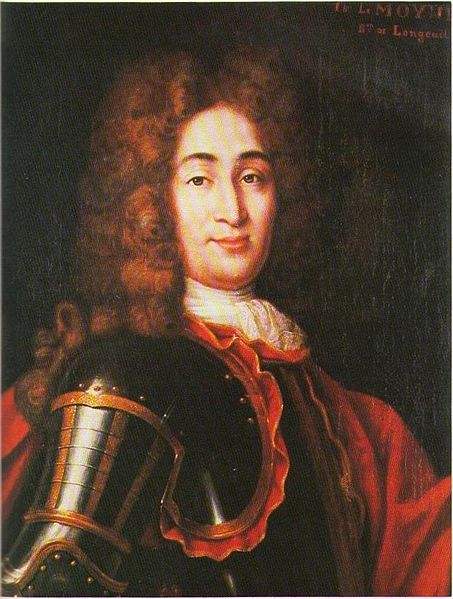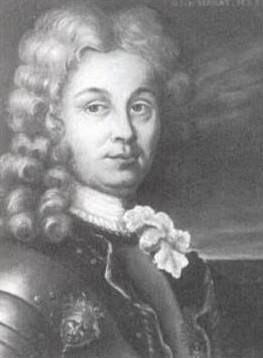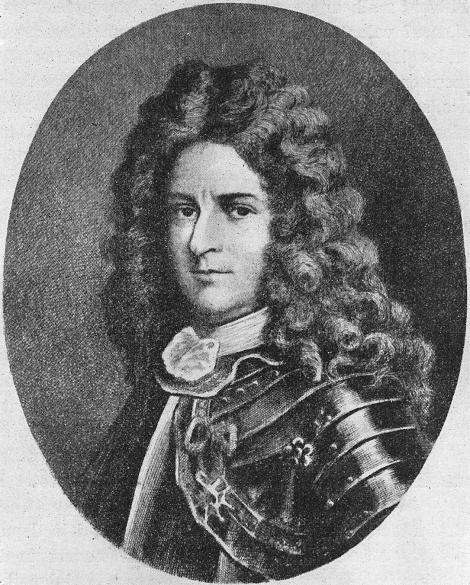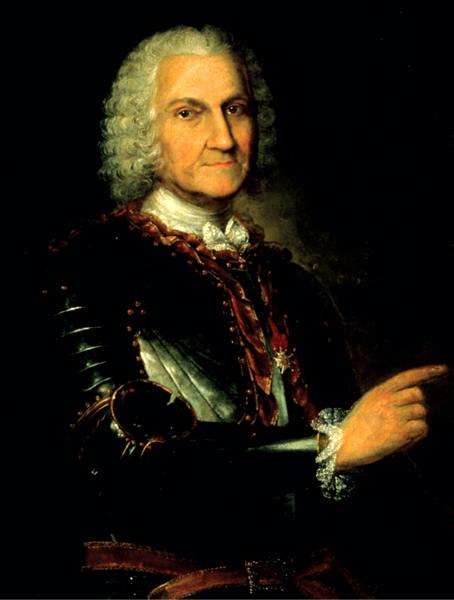Le Moyne
The name of one of the most illustrious families of the New World, whose deeds adorn the pages of Canadian history.
Charles Le Moyne
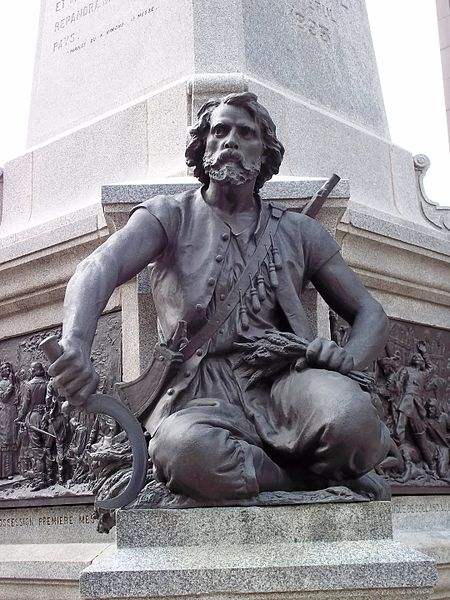
Charles le Moyne de Longueuil et de Châteauguay forms part of Maisonneuve Monument. Picture taken by Jean Gagnon.
Founder of the family, b. of Pierre Le Moyne and Judith Duchesne at Dieppe on 1 August, 1626; d. at Ville-Marie (Montreal), 1683. On reaching Canada in 1641, he spent four years in the Huron country, and then settled at Ville-Marie, his knowledge of the Indian languages rendering him useful as an interpreter, and his valour contributing to defend the colony. He often fought single-handed against Iroquois marauders. This unusual bravery encouraged the settlers to cultivate the soil. In 1653 he negotiated a peace which lasted five years. He married Catherine Primot in 1654. Surprised by a party of Iroquois in 1665, he was preparing to sell his life dearly, when he tripped and was captured. Awed by his valour and fearing reprisals, his captors did not torture, but soon released him. He accompanied Courcelles and Tracy against the Five Nations and shared their success. In recognition of his services Louis XIV ennobled him with the title of Sieur de Longueuil. He served as interpreter to Courcelles and the Governors of Montreal and Three Rivers during a visit to the Iroquois country, and was rewarded by Intendant Talon with a vast concession on the St. Lawrence, reaching from Varennes to Laprairie, henceforth named the Longueuil fief. He was the father of fourteen children, seven of whom honoured Canada by their prowess, three dying in battle and four becoming governors of cities or provinces. Of his sons, surnamed for their bravery the “Machabees of New France”, the two most renowned are treated in separate articles (see below IBERVILLE, PIERRE LE MOYNE, SIEUR D’; BIENVILLE, JEAN-BAPTITE LE MOYNE, SIEUR DE); each of the five others deserves here a short notice.
Charles Le Moyne
The eldest son of the preceding, b. at Ville-Marie, 10 Dec., 1656; d. in 1729. After serving in France, he returned to Canada with the rank of lieutenant, and, at the age of twenty-seven, was appointed major of Montreal by Governor de la Barre. He married Elizabeth Souart. In 1700 he received for his services an additional grant of land and promotion to the rank of baron. He won fame in battle against the Iroquois and in the defence of Quebec (1690). The cross of St. Louis was awarded him, and he was successively governor of Three Rivers and Montreal. In 1711 preceded by the religious standard embroidered by Jeanne Leber, he marched to Chambly against the invading army, which retreated on hearing of the wreck of Walker’s fleet.
Jacques Le Moyne
Sieur de Sainte-Hélène, b. at Ville-Marie, 16 April, 1669; d. at Quebec, 1690. A soldier from early youth, he trained for warfare his illustrious brother, d’Iberville. During Phipps’s siege of Quebec, Ste-Hélène with 200 volunteers repulsed a troop of 1300 men commanded by Major Whalley, who had attempted to cross River St. Charles. Mortally wounded in this encounter, Ste-Hélène died shortly after, mourned by the whole colony for his courtesy and valour. The Iroquois of Onondaga sent a wampum collar as a token of sympathy, and released two captives to honour his memory.
Paul Le Moyne
Sieur de Marlcourt, b. 15 Dec., 1663; d. on 21 March, 1704. He accompanied d’Iberville to Hudson’s Bay, and amply shared his success, particularly in boarding and capturing with only two canoes a large English cruiser. In 1690 he aided Ste-Hélène in defeating Whalley. Frontenac having undertaken a decisive campaign against the Iroquois, Maricourt forced them to surrender. Skilful diplomat as well as intrepid warrior, he was chosen to negotiate peace. His success was due to the affection and esteem of the Iroquois for his uprightness, which moderated their dread of his bravery. They had begged him to act as their protector and mediator. In 1691 he married M. Madeleine Dupont de Neuville.

Manuscript, Commission by Louis de Buade, comte de Frontenac, naming Le Moyne de Maricourt as a replacement of Le Moyne d’Iberville, May 15, 1690.
François Le Moyne
Sieur de Bienville I, b. 1666; d. 1691. After several valourous exploits, he was shot in an encounter with a party of Onneyouts at Repentigny while assailing the window of a house where they had taken refuge.
Joseph Le Moyne
Sieur de Serigny, b. 22 July, 1668; d. at Rochefort, France, in 1704. A worthy emulator of d’Iberville, he commanded the vessels sent from France to enable his brother to take possession of Hudson’s Bay. In that expedition, as well as in Florida and Louisiana, he displayed great valour. With his brothers he drove the Spaniards from Pensa-cola, after which he fortified Mobile and expelled the Spaniards from Ile Dauphin. He was promoted captain in 1720, and in 1722 became Governor of Rochefort, France, where he died in 1734. He had married M Elisabeth Heron.
Louis Le Moyne
Sieur de Châteauguay I, b. 4 Jan., 1676, d. 1694. He fought under d’lberville at Hudson’s Bay, assisting when only a boy at the capture of Fort Monsipi. In the years following he so often defeated the English that they were at last reduced to Fort Nelson (Bourbon), their most important post. This stronghold was likewise captured after a long and difficult attack, during which Châteauguay was killed at the age of eighteen.
Charles Le Moyne
Second baron de Longueuil, b. at Longueuil, 18 Oct., 1687: d. on 17 Jan., 1755. He entered the army quite young, and, after having served in France, was appointed major of Montreal (1733), and received the cross of St. Louis (1734). As Governor of Montreal (1749) he administered the colony after Jonquière’s death. He saved from suppression the General Hospital of Venerable Madame d’Youville, maliciously threatened with destruction. He married Catherine Charlotte de Gray in 1720.
Paul-Joseph Le Moyne
Born 1701; died at Port-Louis France, in 1778. Inheriting the military spirit of his ancestors, he joined the army at the age of seventeen, and served as lieutenant in Normandy. He was successively commander of Fort Frontenac, Governor of Detroit, of Three Rivers, and finally commander of the citadel of Quebec. He fought under Vaudreuil, Montcalm, and Lévis, and won the cross of St. Louis. After the Conquest, he returned to France, where he died at Port-Louis in 1778. He married (1728) Geneviève Joybert de Soulanges.
Joseph-Dominique-Emmanuel Le Moyne
Second son of preceding, b. at Soulanges on 2 April, 1738. He began his military career at the age of twelve. After serving as captain and major under the French régime, he later served under the British flag after the change of domination, bravely defending Fort St. John in 1755 against the American invaders. He was successively appointed inspector general of militia (1777), colonel of the Royal Canadians (1796), and legislative councillor. He died in 1807.
DANIEL, Histoire des grandes familles francaises du Canada (Montreal, 1867); FAILLON, Histoire de la colonie francaise en Canada (Ville-Marie, 1865); MARMETTE, Les Machabees de la Nouvelle France (Quebec, 1882); Documents inedites (Montreal, 1890); JODOIN, Histoire de Longueuil (Montreal, 1889).
LIONEL LINDSAY (Catholic Encyclopedia)
___________________________
Pierre Le Moyne, Sieur d’Iberville
Founder of the colony of Louisiana, b. at Villemarie, Montreal, 16 July, 1661; d. at Havana, 9 July, 1706. He was the third son of Charles Le Moyne, a native of Dieppe Sieur de Longueuil in Canada, and of Catharine Primot. Several of his brothers distinguished themselves greatly as explorers and sailors, viz., the Sieurs de Longueuil, Sainte-Helene, Maricourt, Serigny, Chateauguay, and Bienville. Iberville became a sailor at an early age and served as a volunteer under the Chevalier de Troyes in Hudson Bay. In 1686 he began a brilliant career as soldier and sailor, and took part in many expeditions against the English. In an attack against Fort Rupert, with his brother Maricourt and nine men in two bark canoes, he captured an English ship with fifteen men and the governor of Hudson Bay. In 1694 he took Fort Nelson in Hudson Bay, which he named Bourbon, and in 1696 Fort Pemaquid in Maine. In 1696 also he captured all the English settlements on the coast of Newfoundland, and in 1697 he led an expedition against the English on Hudson Bay. He had a squadron of four ships and a brigantine and commanded the “Pelican” (50 cannon). Separated by ice from his ships Iberville, on 5 Sept., 1697, attacked alone three English ships, sank the “Hampshire” (56 cannon), captured the “Hudson Bay” (32 cannon) and put to flight the “Derring” (36 cannon). He lost his ship and his prize near the mouth of the St. Teresa River, but on the arrival of three ships of his squadron he captured Fort Nelson (Bourbon).
Iberville sailed for France in November, 1697, and was chosen by the Minister of Marine to lead an expedition to rediscover the mouth of the Mississippi River, and to colonize Louisiana, which the English coveted. Iberville’s fleet sailed from Brest on 24 October, 1698. It consisted of two small frigates, the “Badine,” commanded by Iberville himself, and the “Marin,” and two store-ships. At Santo Domingo the warship “Francois” joined the expedition and accompanied it to its destination. On 25 January, 1699, Iberville reached Santa Rosa Island in front of Pensacola, founded by the Spaniards; he sailed from there to Mobile Bay and explored Massacre Island, later Dauphine. He cast anchor between Cat Island and Ship Island, and on 13 Feb., 1699, he went to the mainland, Biloxi, with his brother Bienville.
![The Western part of Canada or the New France where the nations of Illinois, of Tracy [Lake Superior], the Iroquois and many other peoples inhabit. With recently discovered Louisiana Drawn according to the newest reports By P. Coronelli, a cosmographer of the Most Serene Republic of Venice Corrected and augmented by Sir Tillemon. And dedicated to Monsieur Abbot Baudard.](https://nobility.org/wp-content/uploads/2015/03/Western_New_France_1688-e1487782060309.jpg)
The Western part of Canada or the New France where the nations of Illinois, of Tracy [Lake Superior], the Iroquois and many other peoples inhabit. With recently discovered Louisiana drawn according to the newest reports By P. Coronelli, a cosmographer of the Most Serene Republic of Venice. Corrected and augmented by Sir Tillemon. And dedicated to Monsieur Abbot Baudard.
JODOIN AND VINCENT, Histoire de Longueil et de la Famille de Longueuil (Montreal, 1889); Journal of Iberville in MARGRY, Origines Francaises des Pays d’Outremer (Paris, 1881), IV; FORTIER, History of Louisiana (New York, 1904), I.
Alcée Fortier (Catholic Encyclopedia)
_________________________
Jean-Baptiste Le Moyne, Sieur de Bienville
French Governor of Louisiana and founder of New Orleans, b. in Montreal, Canada, 24 February, 1680; d. in Paris, 7 March, 1767. His father, Charles le Moyne de Bienville, settled in Canada in 1640; his three brothers, Iberville, Serigny, and Chateauguay, likewise distinguished themselves in the early history of Louisiana. In 1698-1699, Bienville accompanied his brother Iberville in an expedition despatched from France to explore the territory near the mouth of the Mississippi. They founded a settlement at old Biloxi, where in 1700 Bienville become commandant, and, after Iberville’s death in 1706, governor of the colony.
It was believed in France that Louisiana presented a rich field for enterprise and speculation and a grant with exclusive privileges was obtained by Antoine Crozat for fifteen years. In 1712 Crozat appointed M. la Mothe Cadillac, governor, and M. de Bienville lieutenant-governor. But Cadillac dying in 1715, Bienville once more assumed the reins of government. In 1716, he conducted an expedition against the Natchez Indians, and having brought them to terms, finished the fort “Rosalie” which had been commenced by his brother, Iberville, sixteen years before. In 1717, Epinay, a new governor, arrived in the colony, bringing with him the decoration of the Cross of St. Louis for Bienville. In the meantime, Crozat, failing to realize the great profits he had expected, abandoned the whole enterprise and surrendered his charter to the king in 1717. Another company was at once formed and Bienville received a new commission as governor of the province. He now resolved to remove the headquarters from Biloxi, Mobile, and St. Louis Bay to the more fertile region of the Mississippi River, and in 1718 he selected the site for a new settlement, which he called New Orleans. He left fifty persons there to clear the land and build some houses, but it was not till 1722 that it became the seat of government.
Experience had shown Bienville that the fertile soil of the lower Mississippi, as well as the climate, was well adapted to the cultivation of sugar, cotton, tobacco, and rice, and that Europeans were not fitted for field-work in the burning suns of Louisiana, for they sickened and died. The first plantation of any extent was therefore commenced with negroes imported from Guinea. In 1719, the province became involved in hostilities with the Spaniards in consequence of the war with France and Spain. The governor twice reduced the town of Pensacola and sent detachments to prevent the Spaniards from making inroads into upper Louisiana, and the country bordering on the Rio Grande.
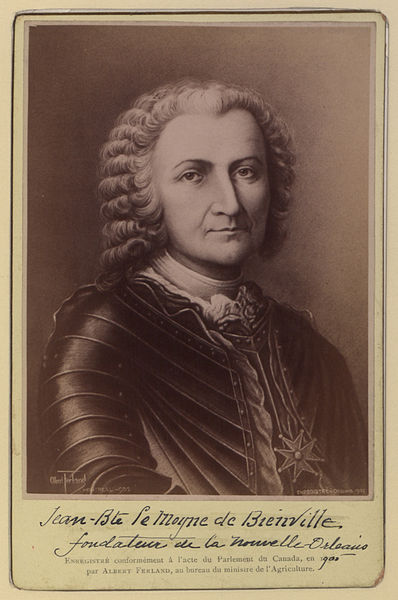 When peace was restored immigrants began to arrive in great numbers from France and Germany. In the autumn of 1726, the Government of Louisiana passed out of the hands of Bienville and he retired to France to recruit his health. In 1734, the king reappointed him Governor and Commandant-General of Louisiana, and early in the autumn he arrived at New Orleans and entered upon the duties of his office. An expedition against the Chickasaw Indians in the spring of 1736 resulted in disaster, but another expedition in 1739 met with better success. This campaign closed his military and official career in the colony. He returned to France under a cloud of censure from the Government, after having faithfully served his country for more than forty years. He was buried with military honours in the cemetery of Montmartre.
When peace was restored immigrants began to arrive in great numbers from France and Germany. In the autumn of 1726, the Government of Louisiana passed out of the hands of Bienville and he retired to France to recruit his health. In 1734, the king reappointed him Governor and Commandant-General of Louisiana, and early in the autumn he arrived at New Orleans and entered upon the duties of his office. An expedition against the Chickasaw Indians in the spring of 1736 resulted in disaster, but another expedition in 1739 met with better success. This campaign closed his military and official career in the colony. He returned to France under a cloud of censure from the Government, after having faithfully served his country for more than forty years. He was buried with military honours in the cemetery of Montmartre.
French, Louisiana Historical Collections (New York, 1846-53), Pt. III, 20-22; Hamilton, Col. Mobile, vii-xiv; Thwaites, Jesuit Relations, LXVI, 342; French, Historical Memoires of Louisiana (New York, 1853), for portrait and valuable additional information.
E.P. SPILLANE (Catholic Encyclopedia)
